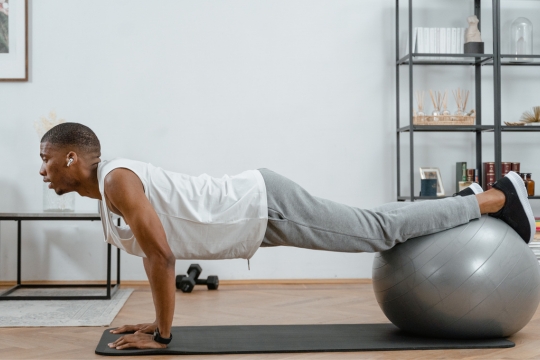Staying steady on your feet isn’t just important for athletes or the older population—in fact, it’s something that benefits everyone. Whether you’re lifting weights, running, playing sports, or simply moving through daily life, having better balance and stability can help you feel stronger, prevent injuries, and improve overall performance.
At Fitness n Motion Health Centre (FNM), we believe in making fitness accessible, fun, and functional. That’s why we’re here to show you how to build better balance with simple but effective exercises. In this guide, we’ll not only cover how to improve balance and stability with exercise, but we’ll also provide practical tips to help you incorporate these movements into your routine. So, let’s get started!
Why Balance and Stability Matter for Fitness and Everyday Life
Balance isn’t just about standing on one foot without wobbling—rather, it’s your body’s ability to control movement and maintain stability. More importantly, it plays a crucial role in everything you do, whether you’re walking, bending down, or reaching for an object on a high shelf. If your balance is off, even simple activities become more challenging, which means you’re more prone to trips, falls, and injuries.
When it comes to gym-goers, balance is a game-changer. Not only does it enhance coordination, but it also strengthens core muscles, allowing you to lift weights, squat, or lunge with better form and control. Additionally, it boosts agility, so that movements become smoother while reducing unnecessary strain on your body. The best part? You can train and improve your balance just like any other fitness skill. Ultimately, knowing how to improve balance and stability with exercise is key to maximizing these benefits.
Best Exercises to Improve Balance
Improving your balance doesn’t require fancy equipment or hours of training. Here are some simple but powerful exercises to strengthen your stabiliser muscles and boost coordination:
1. Single-Leg Exercises
Training one side of the body at a time forces your muscles to work harder to stabilise you. Start with these moves:
- Single-Leg Stance: Stand on one foot for 30 seconds, then switch. Make it harder by closing your eyes or standing on a soft surface.
- Single-Leg Deadlift: Holding a weight in one hand, hinge at the hips, lower the weight towards the floor, and return to standing.
- Bulgarian Split Squat: Place one foot on a bench behind you and lower into a lunge, keeping your front knee stable.
2. Stability Ball Workouts
Adding an unstable surface challenges your core and balance. Try these:
- Stability Ball Squats: Lean against a stability ball on the wall and squat slowly.
- Ball Plank Hold: Place your forearms on a stability ball and hold a plank position.
- Seated Ball March: Sit on a stability ball with feet on the floor, then lift one foot at a time while keeping your core tight.
3. Functional Movements for Core Strength
A strong core is key to good balance. Try these exercises:
- Standing Woodchop: Hold a weight and rotate your torso diagonally like you’re swinging an axe.
- Side Planks: Hold a side plank for 20-30 seconds on each side to strengthen your obliques.
- Toe Taps: Stand on one foot and tap the opposite foot forward, sideways, and backwards without losing balance.
How Balance Training Reduces the Risk of Injuries
Good balance isn’t just about standing still—it’s about controlling movement and reacting quickly to changes in position. As you develop a better understanding of how to improve balance and stability with exercise, your stabilizer muscles become stronger, which in turn allows your body to respond better to sudden shifts. As a result, you reduce the likelihood of rolling an ankle, straining a muscle, or taking a nasty fall.
Moreover, for active gym members, balance training improves how your body absorbs impact, making workouts safer and reducing stress on your joints. If you’re an athlete, it enhances agility and reaction time, helping you move efficiently without overloading certain muscles. In addition, for everyday life, it means fewer missteps, better posture, and less strain when lifting or carrying heavy objects.
Simple Daily Habits to Enhance Stability
Balance training doesn’t have to be confined to gym sessions—you can build stability throughout your day with small adjustments:
- Stand on One Leg While Brushing Your Teeth: An easy way to add balance work to your morning routine.
- Take the Stairs Instead of the Lift: Engages your core and leg muscles while improving coordination.
- Walk on Uneven Surfaces: Try walking on grass, sand, or a soft mat to challenge your balance.
- Engage Your Core During Daily Tasks: When lifting groceries or bending down, activate your core muscles for better stability.
- Use a Balance Cushion at Work: Sitting on a stability cushion or standing on a balance board at your desk improves core strength over time.
Start Improving Your Balance Today
At Fitness n Motion Health Centre, we focus on practical fitness that enhances your strength and mobility in everyday life. Improve balance and stability with exercise to move confidently, enhance workouts, and reduce injury risk. To get started, give these exercises a try, and the next time you’re in the gym, ask one of our trainers for personalized balance-training tips.
A stronger, steadier you starts today—let’s get moving! Now that you know how to improve balance and stability with exercise, be sure to use this knowledge to enhance your fitness journey.
Click here to read more about How to create a balanced workout routine




